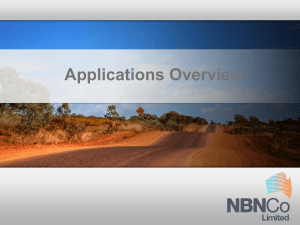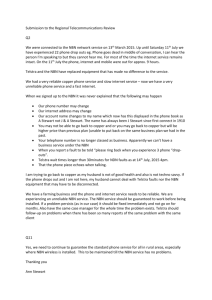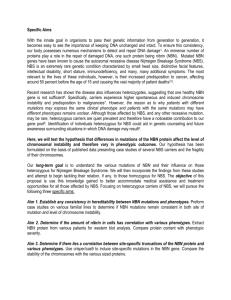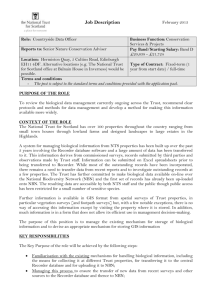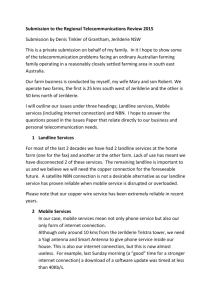the coalition's plan for fast broadband and an affordable nbn
advertisement
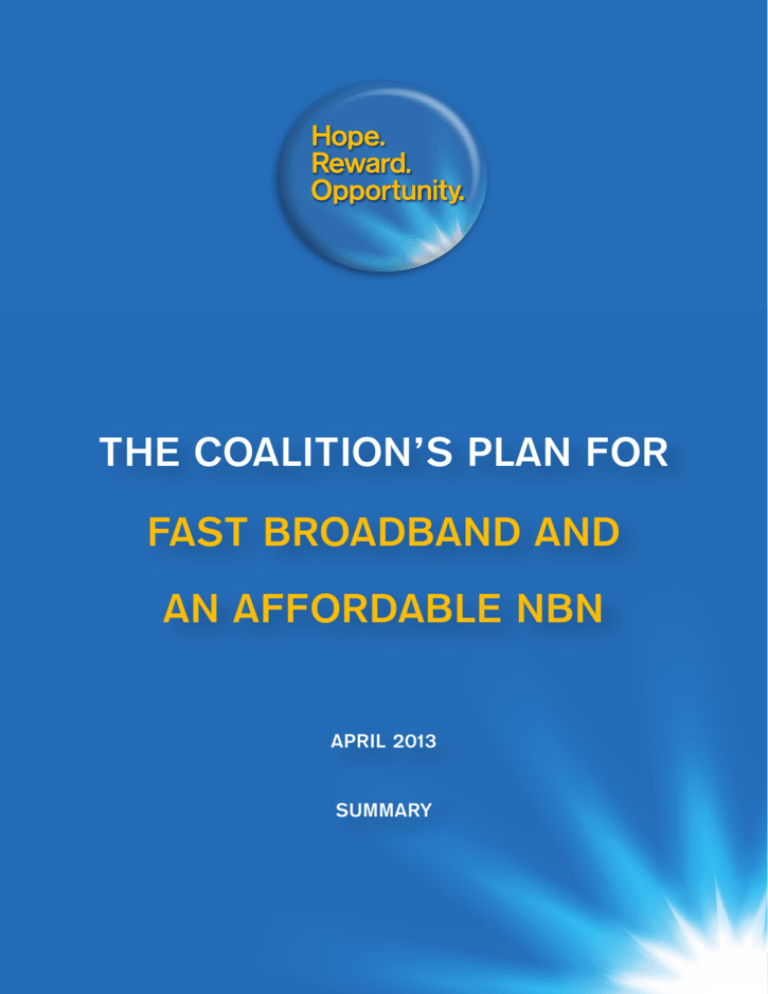
THE COALITION’S PLAN FOR FAST BROADBAND AND AN AFFORDABLE NBN April 2013 Summary The Coalition will deliver fast, affordable and reliable broadband to all Australians. We will complete the National Broadband Network as quickly and costeffectively as possible, using a mix of technologies that will provide high speeds at a reasonable cost. Our goal is for every household and business to have access to broadband with a download data rate of between 25 and 100 megabits per second by late 2016 and between 50 and 100 megabits per second by 2019. Downloads average less than five megabits per second at present.1 Suburbs, regions, towns and business districts with the poorest services and greatest need for upgrades will receive first priority. Key prices for a Coalition NBN will be capped nationally, ensuring Australians in metropolitan and regional areas alike can obtain services at fair prices. In contrast, under Labor’s NBN wholesale charges per user will triple by 2021.2 We will resolve the greatest failure of the current broadband policy: the up to two million households and businesses across Australia that cannot get basic fixed broadband after more than five years of Labor government. 1 Actual download rates in Australia average 4.3 megabits per second. Akamai Technologies, ‘State of the Internet,’ Q3, 2012. Advertised download rates average 9 megabits per second across broadband users according to the Australian Bureau of Statistics (using a weighted average of range midpoints). ABS 8153.0, ‘Internet Activity, Australia,’ Jun 2012. 2 NBN Co, 2012-2015 Corporate Plan, p.69 and p. 72. Page 69 of NBN’s Corporate Plan displays a graph showing a steep rise in the monthly ‘ARPU’ (average revenue per user) NBN Co expects to collect. NBN Co’s financial projections on page 72 show wholesale charges per user increasing from $22/month in 2011-12 to $62/month in 2020-21. The Coalition’s Plan for fast Broadband and an affordable NBN - Summary2 THE ISSUE The Coalition believes all Australians should have access to fast and affordable broadband. Both Labor and the Coalition agree universal, affordable and fast broadband is critical to our future, but Labor has proved incapable of delivering this policy objective in a timely fashion or at a reasonable cost. Unlike Labor, a Coalition government will deliver fast, affordable broadband before the end of 2016. THE CHOICE AT A GLANCE COALITION NBN Scheduled construction period3 2014-2019 Capital expenditure4 $20.4 billion Required funding5 $29.5 billion Download rates 25-100 mbps by end of 2016 50-100 mbps by end of 2019 Plan chosen by most users in 20216 LABOR NBN promised: 2009-2021 likely: 2009-2025 promised:$37.4 billion likely: $71 billion promised: $44.1 billion likely: $94 billion 25-100 mbps by end of 2021 12 mbps 12 mbps 2021 estimated wholesale price/month $38 $62 2021 estimated retail price/month 7 $66 $90 Competition in infrastructure? Yes No Disruption at user premises? No Yes Prices can be less than price cap? Yes No 3 In the first three lines of this table, the first data point provided for Labor’s NBN is the Government’s current estimate. The second figure is the Coalition’s estimate of realistic schedule and costs. The basis for the latter is set out in this policy’s background papers. 4 Capital expenditure is money spent on fixed assets such as equipment, structures or buildings. 5 Required funding is the money a new project or company needs to raise (as equity or debt) to reach a point where it can sustain itself without assistance. 6 NBN Co. 2012-2015 Corporate Plan, p 64. 7 These estimates of retail prices for an average broadband/voice bundle assume that in 2020-21, the dollar margin between wholesale access prices and retail broadband prices is about $28 – the approximate current figure. NBN Co does not have control over retail prices under either party’s policy – these are set by the market. It should be noted that under both scenarios, average retail plans in 2021 will include more (additional services, higher speeds, larger data quotas) than current retail offers. The Coalition’s Plan for fast Broadband and an affordable NBN - Summary3 Labor’s Choice: The most expensive NBN in the world In 2009, Labor committed taxpayers to a more ambitious and costly broadband plan than any other in the world.8 NBN Co was created as a taxpayer-owned monopoly with a mandate to replace Telstra’s copper with fibre (and achieve a competition policy objective: separation of Telstra’s network from its retail business). This decision was made in haste with scarcely any analysis of alternative options and no attempt to measure its costs or benefits. The Coalition’s alternative: choose the most cost-effective technology Broadband policy should be about efficiently meeting community needs, not advocating for a particular technology. Networks should be upgraded in the most cost-effective way using the best-matched technology. This will vary from place to place. Existing infrastructure almost always has a vital role to play. A way to reduce the expense of Labor’s NBN is to extend fibre to cabinets within a few hundred metres of user premises or into the basements of apartment blocks. ‘Fibre to the node,’ or FTTN, increases bandwidth at manageable expense by making use of the existing copper infrastructure over the last few hundred metres before reaching a customer’s premises. THE PLAN The Coalition will deliver fast, affordable and reliable broadband years sooner than Labor. Our aim is that everyone in the nation should have access to broadband with download data rates of between 25 and 100 megabits per second by 2016, and between 50 and 100 megabits per second by the end of 2019 in 90 per cent of the fixed line footprint. We will deliver broadband at less cost to taxpayers. A Coalition NBN will reduce the funding from taxpayers and the capital markets needed to complete the project by $60 billion or two thirds compared to the realistic estimated cost of Labor’s plan. Detailed analysis underpinning the Coalition’s estimate that Labor’s NBN will require more than $90 billion in public funding, twice as much as Labor has so far admitted, is in the background papers released with this policy. We will ensure areas with the poorest broadband receive priority. Incredibly, Labor is allowing NBN Co to waste money building over existing fast broadband networks – even fibre to the premises, known as FTTP, in some cases – while many communities remain without any service at all. Finally, we will ensure that household and small business monthly bills for telephone and broadband services remain affordable. Very fast broadband that is both reliable and affordable can be extended across the nation without the alarming price hikes in prospect under Labor. Leveraging existing infrastructure A Coalition NBN will leverage existing infrastructure. A Coalition NBN will make substantial use of FTTN. This will provide higher bandwidth at manageable costs by reducing the length of the copper connection to a few hundred metres. 8 OECD (2011), ’Fibre Access: Network Developments in the OECD Area’, OECD Digital Economy Papers, No. 182, OECD Publishing, pp. 17-19. Available: http://dx.doi.org/10.1787/5kg9sqzz9mlx-en The Coalition’s Plan for fast Broadband and an affordable NBN - Summary4 Where does fibre to the premises fit? Fibre generally should run all the way to premises in new (‘greenfield’) housing estates and wherever copper has to be replaced, unless this isn’t commercially feasible. Fibre would also typically extend to anywhere there is sufficient demand to justify it - business centres, industrial and commercial parks, schools, hospitals, medical centres and universities are just some examples.9 The Coalition acknowledges that some users may want higher speeds than can be provided over FTTN, before any evidence of such needs in the broader market, and are prepared to pay for it. The Coalition also acknowledges that market needs will clearly evolve over time, and eventually may require further upgrade of the network in areas where fibre has not been extended to user premises. THE CHOICE Both Labor and the Coalition agree on the value of universal fast broadband to households, businesses, the economy and for government service delivery. But Labor has proved unable to deliver these benefits in a timely or affordable manner. On the contrary, Labor’s current NBN is among the slowest and most expensive possible solutions to the question of how to upgrade infrastructure. By the middle of 2013, just a few months before the next federal election, it looks increasingly as though NBN Co will have spent four years and $7.5 billion to run fibre to about one in 50 of the 12.2 million premises its fibre is intended to reach.10 Project budget and scope Over five years, Labor’s NBN has turned into a policy fiasco and a colossal failure of execution. In April 2007 Kevin Rudd and Stephen Conroy promised an NBN built in partnership with private carriers that would cost taxpayers $4.7 billion and be finished by 2013. Almost six years later, the NBN budget has blown out 10-fold according to Labor’s own estimates. NBN Co is now forecast by Labor to require at least $44 billion of capital to finish its network and become financially self-supporting and more realistically will need twice that amount. In contrast, the Coalition’s NBN will require $29.5 billion. Rollout targets The NBN’s rollout and customer targets have been repeatedly missed and slashed. After more than five years of Labor government only 10,400 households are using fibre and the network passes only 72,000 of the 12.2 million premises it aims to serve by 2021. This contrasts with Labor’s promise that by June 2013 the NBN’s fibre network would be available to 1.3 million premises, and in service at more than half a million. 9 In truth almost all large institutions such as universities and major hospitals have been connected directly to fibre for some years, as have the vast majority of schools. This is why the Government’s constant boasts in the early days of the NBN of connecting schools have been hard to provide evidence for in Parliament – the bulk of schools had fibre well before the NBN started. 10 Investment in NBN Co will reach $7.5 billion by June 2013 according to the Mid-Year Economic and Fiscal Outlook 2012-13, p. 285. The Coalition’s Plan for fast Broadband and an affordable NBN - Summary5 In contrast, it is the Coalition’s expectation that our NBN rollout will take place over six years from 2013 to 2019 inclusive, to be completed in 2019. Prices Under Labor’s current policies, user charges per month will, on average, almost treble over the next nine years – a steeper rise than electricity bills over the past nine years. Adjusted for inflation, charges will more than double.11 The Coalition’s policy will avert the need for rises of this magnitude in wholesale revenue per user. We have predicated our business case for the revamped NBN on average wholesale fixed line revenues per user growing no faster than the economy. In other words it will remain stable as a share of the consumer’s wallet. Competition or monopoly? Under Labor, when the NBN is rolled out, Telstra’s copper and Optus’ HFC cables (if present) will be shut down. Telstra’s HFC (if present) may carry Foxtel but not broadband or voice. Labor’s policy is unique in the world in deliberately stamping out competition between fixed line networks. By contrast, the Coalition will remove or waive impediments to infrastructure competition introduced to provide a monopoly to Labor’s NBN, and investigate opportunities to invigorate and enhance competition among retail service providers. COSTINGS The Coalition will spend $20.4 billion on capital expenditure to build its alternative NBN. This is 45 per cent less capital expenditure than the claimed $37.4 billion for Labor’s NBN and 71 per cent less than the more realistic estimate of $71 billion detailed in the background papers released with this policy. The total funding required for the Coalition’s NBN is $29.5 billion. This is 33 per cent less than the claimed $44.1 billion for Labor’s NBN and 69 per cent less than the more realistic estimate of $94 billion detailed in the background papers released with this policy. 11 NBN Co, 2012-2015 Corporate Plan, p.69 and p.72. Pages 69 and 72 of NBN’s Corporate Plan show monthly ‘ARPU’ (average revenue per user) rising from $22/month in 2011-12 to $62/month in 2020-21. Authorised and printed by Brian Loughnane, for the Liberal Party, cnr Blackall and Macquarie Sts, Barton ACT 2600. April 2013. The Coalition’s Plan for fast Broadband and an affordable NBN - Summary6

